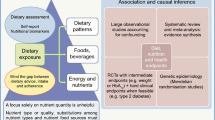Abstract
Background
The accuracy of estimating nutritional intake and balance from photos of meals has not been well documented. However, DialBetics (DB)—our diabetes self-management support system, which is based on information and communication technologies—relies on the photos that type 2 diabetes patients take of their meals with smartphones. Therefore, we designed a study to evaluate this accuracy.
Methods
We prepared 61 dishes whose actual amount/value of total energy and each nutrient were known: protein, fat, carbohydrates, dietary fiber and salt. Their balance—the protein-fat-carbohydrate ratio—was also known, constituting the weighed food record (WFR). Smartphone photos of those dishes were taken, and three registered dietitians evaluated each dish from those photos, naming the dish and estimating the amount of each nutrient in it, plus the dish’s balance. These estimated DB and WFR values were compared using the Wilcoxon matched-pairs rank-sum test; intraclass correlation coefficients (ICCs) were calculated. Agreement between the two values for each dish was assessed by Bland-Altman analysis.
Results
There were significant ICCs—0.84 for fat (95 % confidence interval 0.75–0.90) and 0.93 for carbohydrates (0.88, 0.96)—but no statistically significant differences between DB and WRF for other nutrients or balance. Bland-Altman analysis showed that differences between the two values were random and not biased against nutrient intake; 95 % limits of agreement were acceptable although wide (energy −198 to 210 kcal/dish; carbohydrates −22.7 to 25.8 g/dish).
Conclusion
DB’s diet evaluation by photos is reliable with apparent potential for assessing diets.

Similar content being viewed by others
Abbreviations
- DB:
-
DialBetics
- WFR:
-
Weighed food record
- ICC:
-
Intraclass correlation coefficient
- 24hR:
-
24-hour recalls
- ICT:
-
Information and communication technologies
- apps:
-
Smartphone applications
- PDA:
-
Personal digital assistant
- RD:
-
Registered dietitian
- PFC ratio:
-
Protein-fat-carbohydrate ratio
References
Pastors JG, Warshaw H, Daly A, Franz M, Kulkarni K. The evidence for the effectiveness of medical nutrition therapy in diabetes management. Diabetes Care. 2002;25:608–13.
UKPDS Group. UK Prospective Diabetes Study 7: response of fasting plasma glucose to diet therapy in newly presenting type II diabetic patients. Metabolism. 1990;39:905–12.
Carter MC, Burley VJ, Nykjaer C, Cade JE. ‘My Meal Mate’ (MMM): validation of the diet measures captured on a smartphone application to facilitate weight loss. Br J Nutr. 2013;109:539–46.
Ngo J, Engelen A, Molag M, Roesle J, Garcia-Segovia P, Serra-Majem L. A review of the use of information and communication technologies for dietary assessment. Br J Nutr. 2009;101(Suppl 2):S102–12.
Sharp DB, Allman-Farinelli M. Feasibility and validity of mobile phones to assess dietary intakes. Nutrition. 2014;30:1257–66.
Imai T, Otsuka R, Katou Y, Nakamura M, Ando F, Shimokata H. Advantages of taking photographs with the 3-day dietary record. J Integr Stud Diet Habits. 2009;20:203–10.
El-Gayar O, Timsina P, Nawar N, Eid W. Mobile applications for diabetes self-management: status and potential. J Diabetes Sci Technol. 2013;7:247–62.
Fukuo W, Yoshiuchi K, Ohashi K, Togashi H, Sekine R, Kikuchi H, Sakamoto N, Inada S, Sato F, Kadowaki T, Akabayashi A. Development of a hand-held personal digital assistant-based food diary with food photographs for Japanese subjects. J Am Diet Assoc. 2009;109:1232–6.
Waki K, Fujita H, Uchimura Y, Aramaki E, Omae K, Kadowaki T, Ohe K. DialBetics: smartphone-based self-management for type 2 diabetes patients. J Diabetes Sci Technol. 2012;6:983–5.
Waki K, Fujita H, Uchimura Y, Omae K, Aramaki E, Kato S, Lee H, Kobayashi H, Kadowaki T, Ohe K. DialBetics: a novel smartphone-based self-management support system for type 2 diabetes patients. J Diabetes Sci Technol. 2014;8:209–15.
Yoshiike N, Hayashi F, Takemi Y, Mizoguchi K, Seino F. A new food guide in Japan: the Japanese food guide spinning top. Nutr Rev. 2007;65:149–54.
Takachi R, Kudo Y, Watanabe S, Kimira M. Validity of smaller sample sizes for the dish-based component table to use with the self-reported “dietary record by cooked dishes”. Jpn J Nutr Diet. 2006;64:97–105.
Beasley J, Riley WT, Jean-Mary J. Accuracy of a PDA-based dietary assessment program. Nutrition. 2005;21:672–7.
Lazarte CE, Encinas ME, Alegre C, Granfeldt Y. Validation of digital photographs, as a tool in 24-h recall, for the improvement of dietary assessment among rural populations in developing countries. Nutr J. 2012;11:61.
Acknowledgments
This work was funded by NTT DOCOMO and was partly supported by JSPS KAKENHI grant nos. 23790559 and 24700843. The authors thank Dr. Tsuneyuki Oku and Dr. Katsuhisa Omagari, University of Nagasaki, for their valuable advice.
Author information
Authors and Affiliations
Corresponding author
Ethics declarations
Conflict of interest
SK is a member of the Department of Ubiquitous Health Informatics, which is engaged in a cooperative program between the University of Tokyo and NTT DOCOMO. KW is a member of the Department of Ubiquitous Health Informatics, which is engaged in a cooperative program between the University of Tokyo and NTT DOCOMO. HF is a member of the Department of Ubiquitous Health Informatics, which is engaged in a cooperative program between the University of Tokyo and NTT DOCOMO. HK is a member of NTT DOCOMO. SN, SO, TK and KO declare that they have no conflict of interest.
Ethical standards
This article does not contain any studies with human or animal subjects performed by the any of the authors.
Electronic supplementary material
Below is the link to the electronic supplementary material.
About this article
Cite this article
Kato, S., Waki, K., Nakamura, S. et al. Validating the use of photos to measure dietary intake: the method used by DialBetics, a smartphone-based self-management system for diabetes patients. Diabetol Int 7, 244–251 (2016). https://doi.org/10.1007/s13340-015-0240-0
Received:
Accepted:
Published:
Issue Date:
DOI: https://doi.org/10.1007/s13340-015-0240-0




